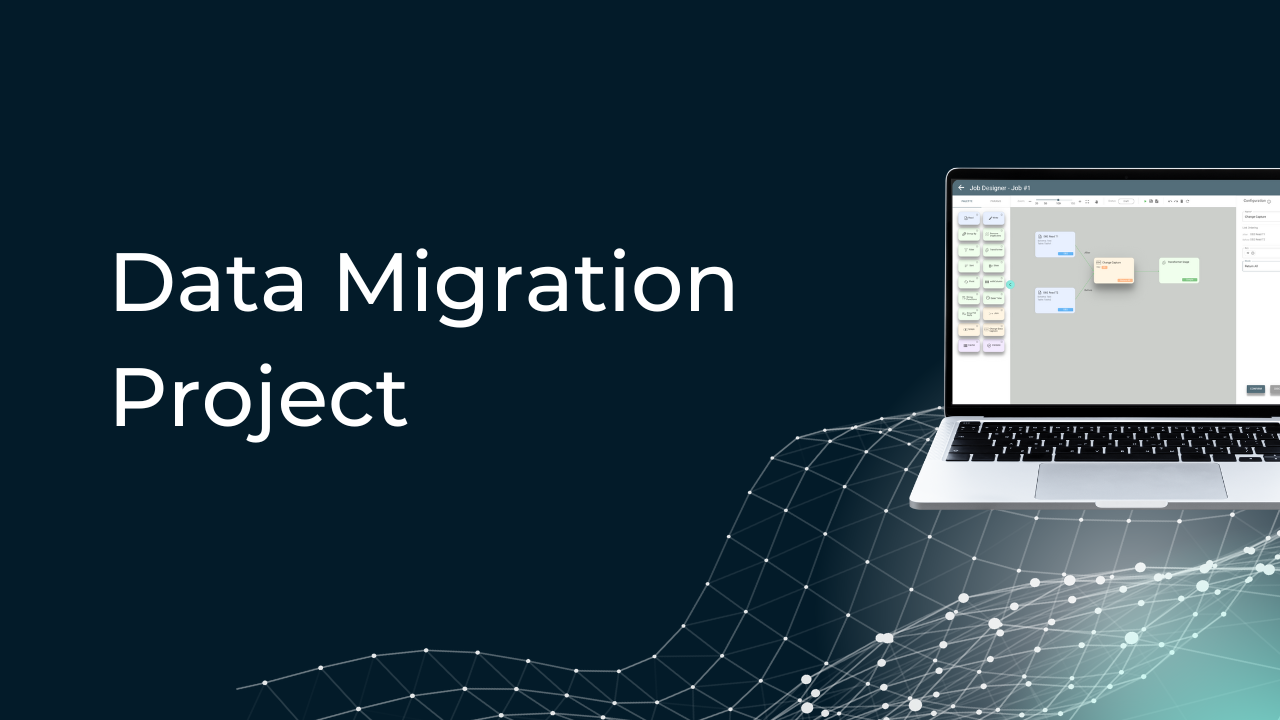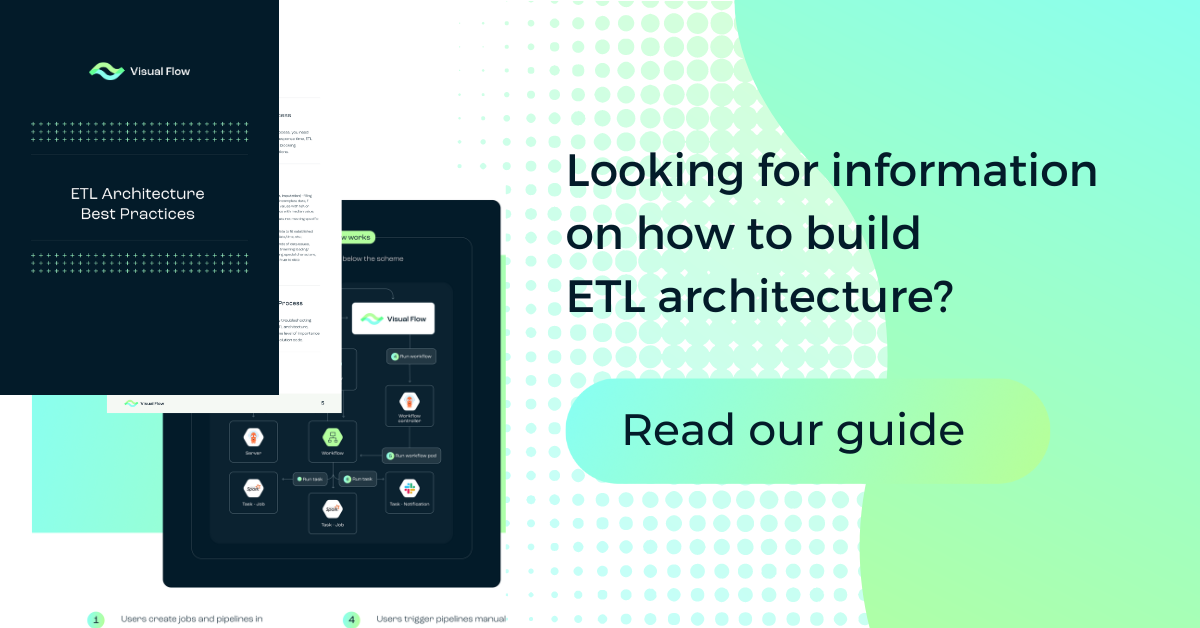Table of Content:
Table of Content:


Learn more about how Visual Flow helped an EU-based logistics company achieve its broader operational objectives.
Logistics — just like “data scaling” is a broad term that can describe a wide variety of important industry actions. However, at its core, logistics is an area of business planning that generally involves making sure things (such as goods and services) get where they need to be, get there safely on time, and, just as importantly, are delivered in the most cost-efficient way possible.
That’s why billions—if not trillions—of dollars are poured into the logistics industry every year. And if the firm in question has a billion-dollar operating model, that means making a single one percent improvement could generate $10 million in additional revenues. And if the firm is operating on an even grander scale, that means the benefits of changing could be even greater.
All we further explain in this case-study-supported guide, data scaling is one of the best ways a logistics-oriented organization can improve its outcomes across the board.
Let’s take a closer look.
Data in the Logistics Industry
Logistics and transportation are arguably two industries that rely on the well-implemented use of data more than others. There are countless different data sets that might be included, such as those relating to customer data, transportation routes, freight costs, and so much more.
The use of data within the logistics industry has become even more important over the past three years, as the COVID-19 pandemic has introduced a variety of data-based anomalies that need to be accounted for.
And better data practices are perhaps even more important for companies with a strong international blueprint, or a blueprint that relies on international unions (like the EU).
Challenges of Data Processing in the Logistic Industry
Perhaps the foremost problem that comes with dealing with data processing in the logistics industry is that the sheer volume of data most logistics companies are working with is so incredibly large. As data volumes continue to increase, the need for more efficient extraction, transformation, and loading (ETL) processes becomes even more important.
Most logistics companies—even those with considerable capital—can only process so much data at once. This creates a precarious position where the logistics company must either continue investing in (increasingly) expensive data engineers or find a way to engage in a more efficient data scaling process.
Fortunately, with platforms like Visual Flow, the transition to an optimized, low-code data scaling solution is more affordable than many logistics managers initially assume.
7 Steps to Scale Data for the Logistics Industry
The process of transitioning to a more efficient data scaling solution (which includes essential processes like ETL) will vary depending on the client. However, generally speaking, this process will usually involve a few critical steps:
- Demo of Product
To determine the ideal platform for scaling ETL tool, a logistics company must first witness a firsthand demonstration of the various options available to them. This is a critical stage in the selection process, as it allows for a thorough assessment of each platform through the asking of pertinent questions.
To facilitate this stage, the Visual Flow team has developed an easy-to-navigate web page. This approach enables the smooth comprehension of how a low code approach can significantly simplify the work of a data engineer, even when tackling complex ETL tasks.
- Define Current Business Structure
Defining the current business structure of a logistics company is critical in identifying the challenges and opportunities within the organization. Knowing the type of business that the company is operating, the customers they serve, and its largest data and ETL challenges allows for a more focused and targeted approach to finding a ETL solution that meets their specific needs. Without a clear understanding of the current business structure, the logistics company may end up with ETL solution that does not adequately address their pain points.
Moreover, a thorough understanding of the business data enables the logistics company to identify areas of improvement and optimization. By analyzing the current business model, they can determine which processes can be streamlined and automated, which will lead to cost savings and increased efficiency. Having a clear understanding of the current business structure is crucial in creating a roadmap for the company’s growth and success, and ultimately, in achieving their goals.
- Preparation of Technical Task (PoV) for the Selected Area
Knowing the technical task or use case (Proof of Value) will help make it much easier to identify the most appropriate scaling platform. For example, the company might face scaling challenges requiring a “layering” approach that becomes less efficient as data volume grows. If that’s the case, then high-performing ETL tools will naturally be a top priority.
- Comparison of Performance
When comparing the performances of various data and ETL tools, it is essential to consider several factors that impact long-term outcomes and total costs.
For instance, the scalability of a solution is crucial as it determines its ability to handle an increasing volume of data over time. It is also important to evaluate the solution’s flexibility and ability to adapt to changing business needs, as well as it’s level of automation and ease of use.
These factors can significantly impact the speed and accuracy of data processing, as well as the overall efficiency of the logistics company’s operations.
Furthermore, comparing the performance of different solutions can help identify potential bottlenecks or areas of improvement. By analyzing the strengths and weaknesses of each solution, the logistics company can make informed decisions about which ETL solution will deliver the best outcomes while minimizing costs. This can lead to significant savings in time and resources, as well as increased accuracy and reliability of data processing.

- Optimization of PoV (Proof of Value)
One way to optimize the PoV for a new ETL tool is to carefully define the success criteria and metrics for the PoV. This will ensure that the PoV is focused on the key objectives and outcomes that the ETL tool is expected to deliver. The success criteria and metrics should be aligned with the overall goals and objectives of the organization, and should be specific, measurable, and achievable. By defining these metrics and criteria upfront, it will be easier to track progress during the PoV and evaluate the tool’s effectiveness.
Another key factor in optimizing the PoV for a new ETL tool is to carefully select the data sets and use cases to be tested. It is important to choose data sets that are representative of the organization’s data, and to select use cases that are critical to the organization’s success. By selecting the right data sets and use cases, it will be easier to demonstrate the value of the ETL tool and to convince stakeholders of its effectiveness. In addition, it is important to ensure that the PoV is conducted in a controlled environment with clear guidelines and protocols for data processing and analysis.
- Implementation of Other Processes
When it comes to large-scale data management within the logistics industry, there may need to be other processes modified as well, such as reporting processes, data-gathering policies, data governance and more.
The success of any ETL implementation will depend on a variety of factors, including the overall goals and objectives of the organization, the specific data management and storage systems in place, and the technical expertise and resources available to implement and manage the new processes.
By taking a comprehensive approach and addressing all of these factors, logistics companies can ensure that they are able to effectively manage data scaling and utilize the large amounts of data generated by their operations, leading to improved efficiency, better decision-making, and increased competitiveness in the marketplace
- Continuous ETL Process Improvement
Continuous improvement of ETL processes is crucial to effectively managing data in the ever-evolving logistics industry. This is where an easy-to-use platform can be incredibly beneficial, particularly one with a low-code, drag-and-drop format.
- Necessary Technologies for Data Scaling in the Logistics Industry
When determining the best technologies to use for logistics industry data scaling, it is important to implement a holistic approach that accounts for every component of the industry.
The best logistics data scaling solutions will involve limited amounts of code, will include a customizable platform that can be easily adapted to environmental changes, and will also offer ongoing support to ensure these changes are made correctly.
Real Case of Data Scaling for the Logistic Company by Visual Flow

Who is the Client?
In this particular case study, the client working with Visual Flow ETL solutions is a large logistics company that provides transportation services for a variety of clients. Naturally, as someone with a dual focus on logistics and transportation, finding better ways to manage both historical and recent collections of data would be incredibly important.
The Problem Faced by the Client
As the company in this case continued to expand its operations, the types—and, especially, the volume—of data it needed access to was also growing, as well. Once the data sets the company was working with exceeded a particular number of rows (inputs), processing any additional data would require a few extra steps. This created inefficiencies in the data scaling process, particularly regarding the “extract, transform, and load (ETL)” components of the process.
As the volume of unstructured data continued to grow, processes came remarkably more complicated, which, in turn, created a new set of challenges for data engineers and developers. While the client tried to apply a few short-term solutions to the issue at hand, maintaining the data flow became a huge “time suck” that involved many billable hours from very expensive, experienced developers.
The client faced a few other notable problems as well. For example, while they attempted to make the data more manageable by dividing it into multiple subsets, not all of the data could be easily divided or managed, meaning that future adjustments would still be needed. Additionally, logistical challenges introduced by the COVID-19 pandemic meant that—while implementing better data in logistics practices was more important than ever—making the appropriate changes had suddenly become even more challenging.
The Solution that Was Provided
In response to the aforementioned problems, it became clear that the logistics client would need to change the ways that data was managed and scaled. However, rather than simply making change for the sake of change, they know they needed to make the right change—one that would simultaneously balance their need for high performance and efficiency, the ability to directly manage unstructured data, the ability to monitor data loading pipelines, as well as the ability to operate without the high cost that comes with using the most expensive data engineers.
There was also a significant amount of emphasis on flexibility, especially knowing that COVID-19, along with other industry-wide developments, would introduce the need to quickly be able to work with new data sets.
Naturally, the combination of these needs made the logistics client a perfect contender to use Visual Flow, which is a platform that provides low-code solutions designed to help its clients better manage the extract, transform, and load (ETL) portion of data scaling.
Result
In the end, Visual Flow provided the ideal combination of functionality, scalability, customization, and cost efficiency. The client was very happy with the final product, including the drag-and-drop interface that helps considerably eliminate the need for excessive code.
Furthermore, the client was pleased to see that all of the data could be kept in a single location, which made the new solution even better than the temporary data breakdown provided by the (extremely expensive) previous data engineers.
Now, the logistics client has a flexible collection of data that can be easily modified or transformed in the future—no matter what that future might have in store.
Conclusion
Ultimately, it is easy to see why so many clients within the logistics space choose Visual Flow as their go-to data scaling solution (especially regarding ETL practices). Finding these sorts of solutions is especially valuable in a rapidly changing ecosystem where the ability to make quick—and efficient—changes is a universal need.
FAQ
The best way to scale data for the logistics industry is to use a low-code, efficient platform such as Visual Flow. Visual Flow makes it easy for companies within the logistics industry to incorporate new data sets, make adjustments, and minimize the cost of utilizing new data. The simple drag-and-drop format is compatible with both new users, as well as those with significant data scaling experience.
The logistics industry involves a remarkable amount of data usage. Being able to scale data more effectively (including ETL solutions) will help put any logistic-reliant or transportation firm in a position where it can adapt and gain an immediate competitive edge.
There are many things that will need to be considered when comparing data scaling tools. Be sure to understand your business’s current structure, and long-term goals, as well as the types of data you will typically be using. Balancing the ongoing needs for efficiency, flexibility, and affordability will be very important.
Contact us































































